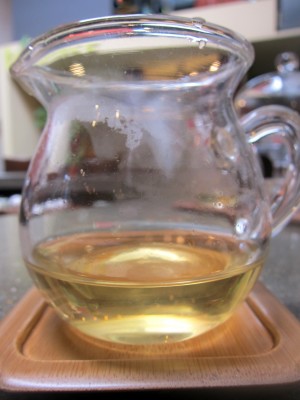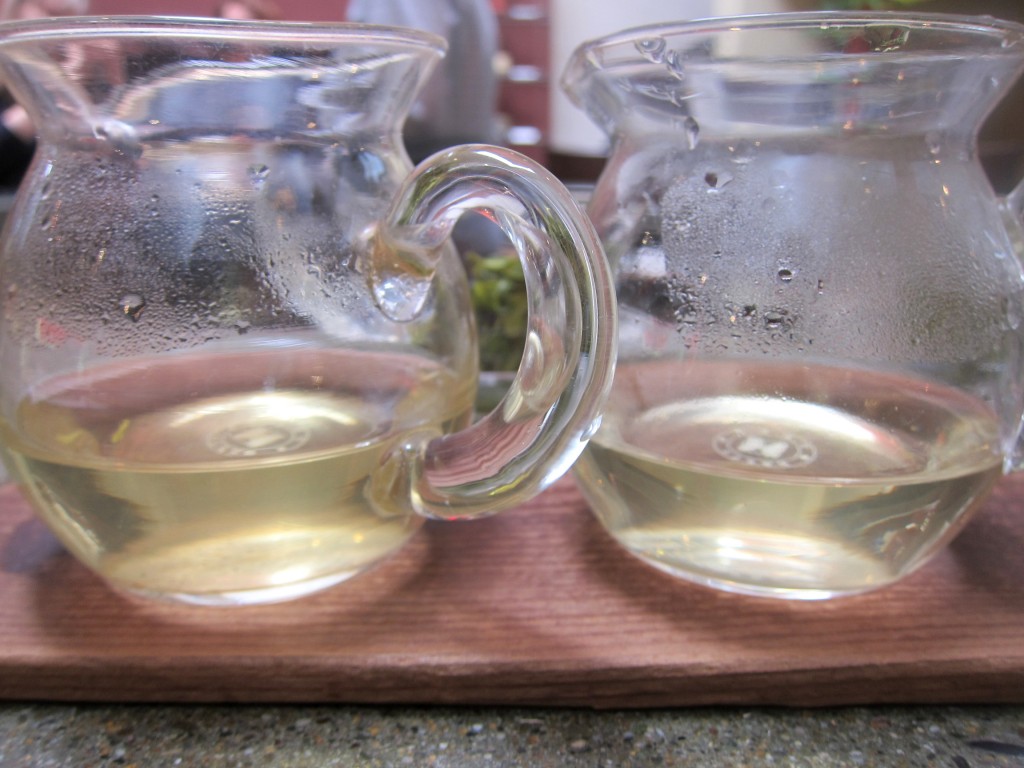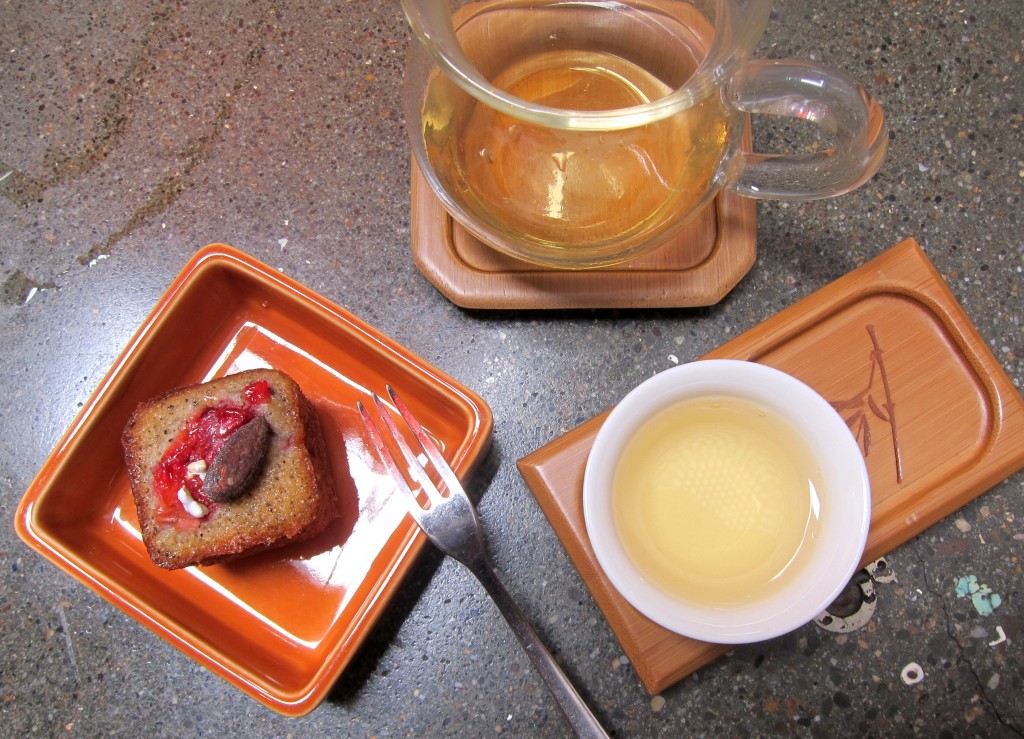
The new spring harvest teas are arriving at Teance, and so am I. I tried three teas earlier today, a yellow tea, a green tea and a white tea, all of which I have had from previous seasons, but a new season comes with new tastes, and today was the first time I truly felt the fleeting beauty of tea, something that changes not just from season to season, from day to day, but even one second can be different from the next.
To start, I asked Genevieve, the tea bartender, for a pot of Anhui Yellow. What I remember about Anhui Yellow 2012 was the deep sweetness of roasted coffee beans, which I could not feel from this Spring 2013. The uniqueness of Anhui Yellow 2012 was the re-moist process, the uniqueness of Anhui Yellow 2013, as Darius(*) and Genevieve told me, is the “bake” – it is the only type of green tea that goes through 3 days of baking, where it is piled, covered and baked from underneath, which sounds similar to the “re-moist” process in the previous description. Whichever changes given to the method, be it in name or in the actual process, this year the Anhui Yellow tastes different from last year. For the first steep, it had “smokey”, as both Darius and Genevieve say, at least in the aroma, but the overall taste actually leaned toward milky for me. Granted, I made the mistake of eating a ham-and-cheese sandwich right before arriving (to avoid being famished like every other time I’d spent hours at Teance), which the Anhui Yellow complemented a little too well.
It was not until the second steep that the milky note turned into really smokey, and for a very short moment when I had a big gulp, the aftertaste was almost beany enough to remind me of roasted coffee. A minute of two later, long after the tea had gone down, I recognized a comforting sensation all over the back of my throat. Anhui Yellow has a subtly sweet aftertaste. Finally, when the tea cooled to room temperature, it tasted like the young little bean inside a boiled unripe green bean pod.
Not wholly satisfied with the Anhui Yellow, I opted for another new arrival: Dafang of Spring 2013, a green tea. Last year, I wrote that the Dafang was “a lot simpler, nuttier, and more straightforward” than its cousin Longjing (Dragon Well), it also “lacked the vegetal note of the Longjing”. This year could not be more different. Dafang 2013 is exceptional! The first taste: pristine. Actually, my first thought was “sharp”, then I changed the word to “clean”, and Darius said “like a Samurai sword?” I said yes. But in a good way. Something brilliant and strong, but delicate.(**)
But that was only the first sip. Then it developed into a world of grilled mushroom, eryngii in fact, with a peppery note. Now I was wondering had I gone drunk. I probably was, despite the ham-and-cheese sandwich earlier, green tea is strong and my hands started shaking. The mushroom note was gone in the second steep. In the third, it became vegetal, with a chicory hint. I actually started giving up on trying to find a word to describe a taste that vanished just as soon as I touched its tail end. The more I thought about it, the wider blank I drew.
My mind was so empty that I asked Darius to choose the next tea. As tasting goes, I find “omakase” (“I’ll leave it to you”) to be the best way to enjoy a product when you’ve become acquainted enough with that type of beverage or cuisine, and when the bartender or the chef also knows you enough to know your preference and your comprehension level. You have to be acquainted enough to have developed a preference. For example, I prefer sweet, floral and vegetal notes to smokey, earthy, or roasty ones, so a Baochong wins me over a Tieguanyin almost any day. Comprehension is important, too, because appreciating tea, much like appreciating wine or sake or heirloom tomatoes, takes practice, and one slowly climbs up the ladder of appreciation as one’s tastebuds develop and discern deeper levels of the taste. If a tea is below my comprehension level, I would be bored. If it’s too far above, I wouldn’t get it and therefore couldn’t enjoy it to its fullest potential. The perfect level is a little bit above my level, so that I can see it but hardly grasp it. Today, the White Peony was perfect because I could see its sweetness very clearly, yet could not for the life of me describe it.
I can describe what it is not. It is not sweet with a tangy hint like strawberry or raspberry, it is not plumy, it is not peachy, it is not sweet like mango or sweet potato or honey or sugar from sugar cane, it is not sweet with a green, vegetal taste like bokchoy or spinach. It is somewhat sweet like the smell of apple blossoms, or perhaps the smell of pine needles? It changes quickly in different hues. After focusing all of my attention and failing to dig out a satisfactory word to describe the first four or five cups, I decided that it was best to describe the White Peony of spring 2013 as it is: sweet like a White Peony tea.
When I left Teance, physically, I felt like a snowman under the sun, brightened and melting. Mentally, my mind was blank but I was taking in all of the smells and sounds around me at once. It was weird. I don’t understand why the tea had such a strong effect on me today, but I was enjoying myself.
(*) Darius Moghaddam is one of the managers at Teance.
(**) The description of this year’s Dafang posted on Teance website:
The original ‘Dragonwell’, a pressed flat yellow shaped leaf of the bud and leaf set, hand pressed in a hot wok. Grown on high mountains away from the city centers that Dragonwell is subject to, the pristine air and water quality produces a high chestnut fragrance and long lingering fresh taste on the palate. We feel that the Dafang Green is superior to the Dragonwell Green this year, so please taste and compare!
Could the Samurai sword taste that I felt be the “fresh” taste they mentioned? 😀


hello there and thank you for your info – I
have definitely picked up something new from right here.
I did however expertise some technical issues using this web site, since I experienced to reload the website many times previous to I could get it
to load properly. I had been wondering if your web host is OK?
Not that I am complaining, but slow loading instances times will often affect your placement in google and could damage
your high-quality score if advertising and marketing with Adwords.
Well I’m adding this RSS to my e-mail and could look out for much more of your respective exciting content. Make sure you update this again very soon.
They’re all right, but if you have tea leaves iasetnd of a bag of tea, then use a coffee filter, and put the leaves in it, and pour water in the back just as if you’re making coffee.